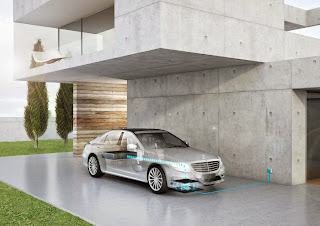Germany believes in inductive charging
Daimler and the BMW Group have signed an agreement on the joint development and implementation of a standardised technology for inductive charging of electric cars and plug-in hybrid vehicles. The advantage is the cable-free connection between the supply point and the vehicle’s high-voltage battery.
The system consists of two components: a secondary coil in the vehicle floor as well as a base plate with integral primary coil that is located underneath the car, for example on the garage floor. The arrangement of the coils, and consequently of the field pattern, is based on a design derived from their circular shape that offers a number of crucial benefits. These include the extremely compact and lightweight construction along with effective spatial confinement of the magnetic field.
The electrical energy is transmitted via an alternating magnetic field generated between the coils, contact-free, without charging cables and at a charging rate of 3.6 kW. With an efficiency factor of over 90 percent, this method enables the high-voltage batteries in vehicles to be charged efficiently, conveniently and safely.
A further development target is to minimise the charging time for contactless power transmission. At a charging rate of 3.6 kilowatts, the high-voltage batteries in many plug-in hybrid vehicles (i8 or S500 plug in) can be fully charged in under three hours. In order to make allowance for the higher storage capacities of high-voltage batteries in pure-electric vehicles, the future technology standard also foresees the possibility of increasing the charging rate to 7 kW. This ensures that the battery in a BMW i3 or a electric B-Class could still be fully charged overnight when using the inductive system.
The system consists of two components: a secondary coil in the vehicle floor as well as a base plate with integral primary coil that is located underneath the car, for example on the garage floor. The arrangement of the coils, and consequently of the field pattern, is based on a design derived from their circular shape that offers a number of crucial benefits. These include the extremely compact and lightweight construction along with effective spatial confinement of the magnetic field.
The electrical energy is transmitted via an alternating magnetic field generated between the coils, contact-free, without charging cables and at a charging rate of 3.6 kW. With an efficiency factor of over 90 percent, this method enables the high-voltage batteries in vehicles to be charged efficiently, conveniently and safely.
A further development target is to minimise the charging time for contactless power transmission. At a charging rate of 3.6 kilowatts, the high-voltage batteries in many plug-in hybrid vehicles (i8 or S500 plug in) can be fully charged in under three hours. In order to make allowance for the higher storage capacities of high-voltage batteries in pure-electric vehicles, the future technology standard also foresees the possibility of increasing the charging rate to 7 kW. This ensures that the battery in a BMW i3 or a electric B-Class could still be fully charged overnight when using the inductive system.




Ce commentaire a été supprimé par un administrateur du blog.
RépondreSupprimer